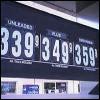Session Overview

|
You may not realize it, but every time you purchase something, you are participating in a market for that good. Some people supply it, and some people—you!—demand it. In this lecture, we will examine how to analyze supply and demand curves and the impact changes in market conditions and government policy can have on market equilibrium. Government intervention can impact gasoline prices. Image courtesy of Aaron Tyo-Dikerson on Flickr. |
Keywords: Supply and demand; equilibrium; demand shift; supply shift; government interference.
Session Activities
Readings
Read the recitation notes, which cover new content that adds to and supplements the material covered in lecture.
Before watching the lecture video, read the course textbook for an introduction to the material covered in this session:
- [R&T] Chapter 3, “Demand and Supply.”
- [R&T] Chapter 4, “Applications of Demand and Supply.” Sections 4.1-4.2.
- [Perloff] Chapter 2, “Supply and Demand.” (optional)
Lecture Videos
Resources
Further Study
Question 1
What determines the price and quantity of a good in a perfectly competitive market?
In a perfectly competitive market, the equilibrium price and quantity sold is given by the intersection of the supply and demand curves. The position of the demand curve and the presence or absence of substitute goods are also relevant, but these answers are incomplete.
Question 2
Assume that people enjoy eating either apples or oranges. What happens in the market for oranges when the price of apples goes up?
When the price of apples increases, more people will eat oranges because they are more affordable. This causes the demand curve to shift right: at any given price point, people will consume more oranges.
Question 3
Now, assume there is a frost in Florida that destroys part of the orange crop. What happens to the market for oranges in this case?
When part of the orange crop is destroyed, there are less oranges available at any price; the supply curve shifts left to a new equilibrium with lower quantity and higher price. An alternative way to conceptualize the change is that the cost of growing fruit, per orange sold, has now increased for the farmers; they are still paying to run their farm, but are selling fewer oranges. For each orange they now sell, they need to charge more.
Question 4
The government imposes a minimum wage for workers. Which of the following phenomena is NOT a consequence of this policy change?
The minimum wage leads to an increase, not a decline, in the average wage paid. At the same time, however, it leads to an increased supply of labor by workers and a decreased demand by employers, which results in unemployment.
Question 5
What is a potential cost of disequilibrium in a market?
Market disequilibrium introduces a variety of costs. First, there may be efficiency loss when trades don't get made (e.g., consumer is willing to buy gas at below the minimum price, and a supplier is willing to sell gas at that price, but no sale occurs.) Second, it may be costly for the gas supplier to decide who should receive gas when demand exceeds supply. Third, people may waste time waiting for gas that they could productively use working. However, government interventions that decrease efficiency may also increase equity. This will be discussed more in later lectures.
These optional resources are provided for students that wish to explore this topic more fully.
Study Materials
See the course website for Econ 302, Intermediate Microeconomics taught at Penn State in 2011.










